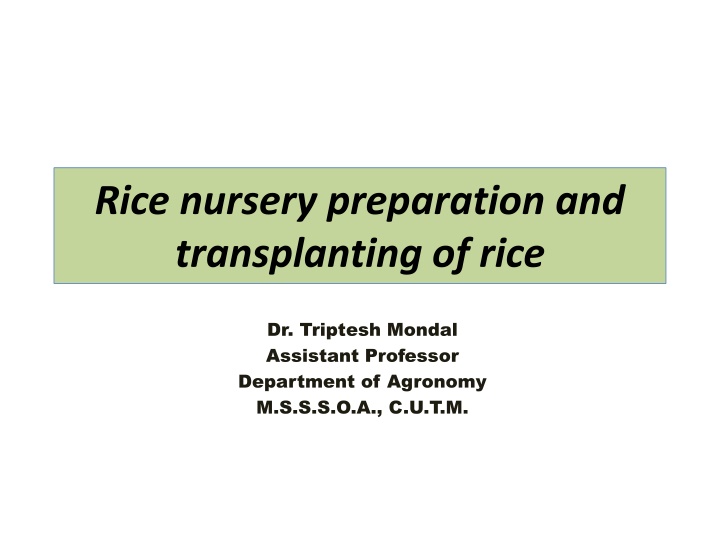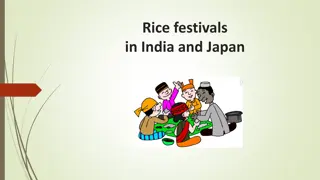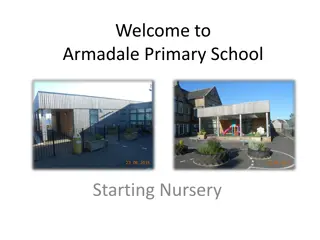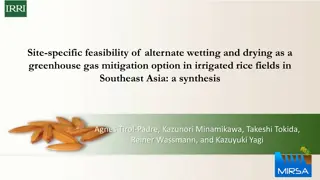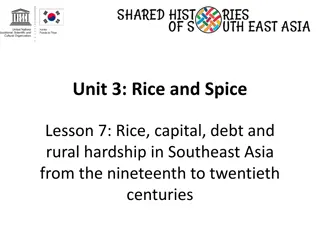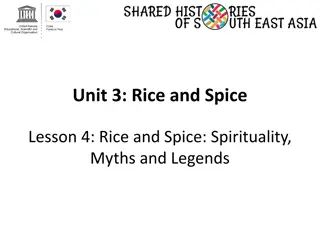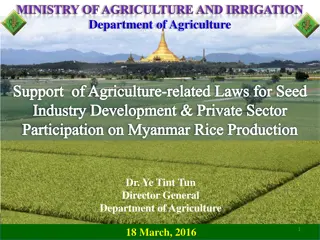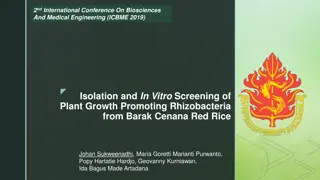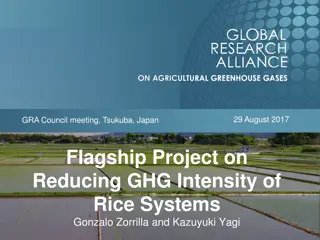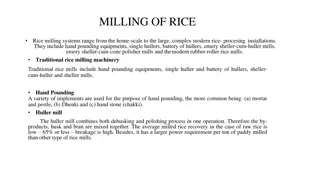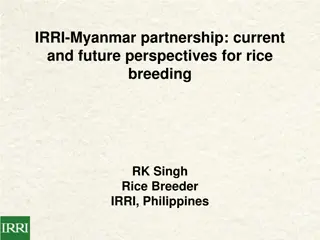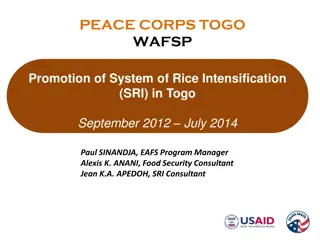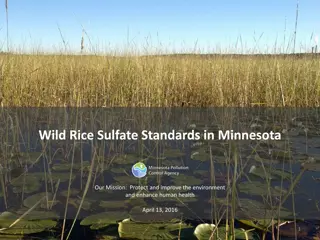Rice Nursery Preparation and Transplanting of Rice
Learn about different methods of rice nursery preparation and transplanting techniques as explained by Dr. Triptesh Mondal, an Assistant Professor in the Department of Agronomy. The article covers dry nursery preparation, wet nursery setup, and Dapog nursery method with detailed instructions on seed preparation, transplanting timelines, nutrient management, and seed treatment options.
Download Presentation

Please find below an Image/Link to download the presentation.
The content on the website is provided AS IS for your information and personal use only. It may not be sold, licensed, or shared on other websites without obtaining consent from the author.If you encounter any issues during the download, it is possible that the publisher has removed the file from their server.
You are allowed to download the files provided on this website for personal or commercial use, subject to the condition that they are used lawfully. All files are the property of their respective owners.
The content on the website is provided AS IS for your information and personal use only. It may not be sold, licensed, or shared on other websites without obtaining consent from the author.
E N D
Presentation Transcript
Rice nursery preparation and transplanting of rice Dr. Triptesh Mondal Assistant Professor Department of Agronomy M.S.S.S.O.A., C.U.T.M.
1. D ry/D ry-B ed N ursery Dry nursery is prepared in areas where sufficient supply of moisture is assured through rainfall and where soil is friable to retain moisture. In this method, the field is ploughed repeatedly to a fine tilth and raised beds of 5 to 10 cm height, 1 to 1.5 m width and of convenient length are prepared keeping 30 cm wide channel in between. Seed preparation: (a) Seeds are sown directly or after treating with brine solution (i.e., 250 g NaCl in 1 litre of water) + biological or chemical treatment (for local rice varieties). (b) For getting pre-germinated/sprouted seeds, soak the seeds with normal water for 24 hours. Drain the water and incubate the seeds for 36-48 hours in a warm shady place and are never allowed to dry up by occasional moistening the seeds. Sow the sprouted seeds when radicle grows 2-3 mm long.
After sowing, seeds may be covered with a mixture of sand and well decomposed farm yard manure (FYM) to a thickness of 5 mm. Sow the seeds in rows 10 cm apart in dry or moist condition of soil. Maintain thin film of water if possible at 5 days after sowing (5 DAS). Seed rate of nursery bed: 2.5-3.0 kg/100 m Nursery area: 1000 m for 1 ha main field Nutrient management: 8.28 kg N, 6.4 kg P O and 2.0 kg K O per 20 cents or 800 m area. Seedlings on the dry bed should be ready for transplanting at 25 DAS onwards (25DAS - 35DAS). Seed treatment with bio-control agents like Pseudomonas fluorescens @ 10 g/kg seed or chemicals like carbendazim 50% DF @ 3 g/kg seed for local rice varieties.
2. W et/W et-B ed N ursery Wet nursery is prepared in areas where sufficient supply of irrigation water is assured. For wet seedbed nursery, land is 1st ploughed under moist or dry condition and then puddled by ploughing repeatedly (i.e., 5- 6 times) in 5-7 cm standing water. After that raised beds of 5 to 10 cm height, 1 to 1.5 m width and of convenient length are prepared keeping 30 cm wide channel in between similar like dry nursery. Seed preparation: normal seeds or pre-germinated seeds are used. Seed rate and fertilizer application rate are same as practiced in dry nursery. Seeds are broadcasted uniformly on a raised bed in a crosswise manner. The seedlings are ready for transplanting at 15-35 DAS. Nursery area: 1000 m for 1 ha main field
3. D apog N ursery/M at N ursery This method of seedling raising is commonly prevalent in the Philippines and has been introduced in India. The essential feature of this method is to have a very thick nursery seedlings without any contact with the soil. Raised beds are prepared similar to wet nursery. The beds are covered with banana leaves (mid-rib removed) or empty cement or fertilizer bags or polythene sheets to prevent the roots of seedlings from coming in contact with soil. A wall of 5.0 to 7.6 cm high is made of strips of banana leaves on the 4 sides of the beds to keep the seeds in place after they are sown.
Seed rate: Pre-germinated seeds of 3 kg/m Uniform sowing should be done through broadcasting of seeds in a crosswise manner. Water is splashed on the germinating seeds and the seeds are pressed down slightly by hand or light wooden plank in morning and afternoon twice for 3-6 DAS. This prevents exposure of roots to the air and helps germinated seeds to remain in touch with each other and with the ground. The seedlings are kept moist by sprinkling water for initial 3-4 days after germination. Seedlings become ready for transplanting within 12-14 DAS regardless of duration of the rice variety. Fertilizer application is not needed since the seedlings are nourished by nutrients present in the seed.
4. M odified M at N ursery for SRI The modified rice mat nursery is an improvement over the age old Dapog nursery. In this modified mat nursery method, a thin layer of seedbed with rooting medium is provided to get robust and healthy seedlings fit for transplanting at young age (generally, 8- 12 DAS and maximum upto 14 DAS). Seedbed specification is similar to dry nursery. Seedbeds are covered by perforated 300 gauge polythene sheet to prevent roots growing deep but facilitating drainage of water underneath. Wooden frames are used. Seedbed medium is prepared with native soil and well decomposed FYM (1:10 ratio) or vermicompost. Seedbed medium is mixed with powdered DAP @ 1 kg/ha (i.e., 25 g/m seedbed). Seed rate: Sprouted seeds of 5-7.5 kg/ha (i.e., 50 g/m )
Nursery area: 100 m for 1 ha main field Seedbeds are covered with well threshed paddy straw to avoid admixture of seeds upto 5 DAS. Water is sprinkled using rose can up to 5 DAS in morning and evening twice. Seedlings can be lifted as cakes and easily transported to the main field for transplanting when seedlings attain 2-3 leaf stage (i.e., 8-12 DAS). 18-20 cm tall and robust seedlings can be obtained in 8-12 days time period under this method. Transplanting Depth of transplanting: Not more than 2-4 cm depending upon the extent of puddling done and the time lapse between puddling and transplanting. Spacing: Generally, 20 cm 10 cm (50 plants/m ), 20 cm 15 cm (33 plants/m ) and 15 cm 15 cm (44 plants/m ) are ideal spacings for transplanting of rice seedlings.
Seedling/hill: Transplanting of healthy seedlings may be done in puddled soil at 4-5 leaf stage or when they are about 20-25 cm in height @ 2-3 seedlings/hill in case of high yielding rice varieties (HYVs) and @ 1-2 seedlings/hill in case of rice hybrids where tillering is more profuse. System of rice intensification: 1 seedling/hill is preferred. Widely spaced square planting (i.e., 25 cm 25 cm or 50 cm 50 cm) is done. Application of well decomposed FYM in the main field @ 5 t/ha is done. Double transplanting: Rice seeds should be sown in nursery during early in May. Seedlings of 21 to 35 days age are transplanted in the secondary nursery at a spacing of 15 cm 10 cm (67 hills/m ). Seedlings from the 2nd nursery should be uprooted after 21 to 35 days after transplanting and finally transplanted in the main field. Thus, the age of seedlings in the main field is 42 to 70 days. In 1st nursery bed fertilizer rate is similar to dry and wet nursery. In 2nd nursery bed, 20 kg/ha N, 10 kg/ha P O and 10 kg/ha K O are applied.
Advantages of transplanted rice: a) All weeds, which otherwise compete with rice plants for nutrients and moisture are killed and buried. b) The infiltration rate of water is reduced and water retaining capacity of soil increases. c) The soft mud facilitates transplanting. d) The germinated seeds and seedlings are established in soft mud easily. e) Plant population become more assured than direct seeding. Disadvantages of transplanted rice: a) Transplanting is a tedious job and skilled labours are required. b) Seedling can be exposed to possible injury during handling. c) After transplanting, plants tend to grow slowly than direct seeding because of recovery time requirement from the transplanting shock.
